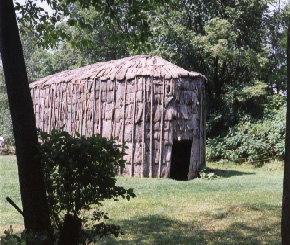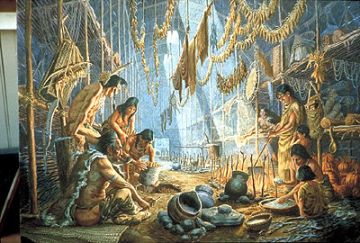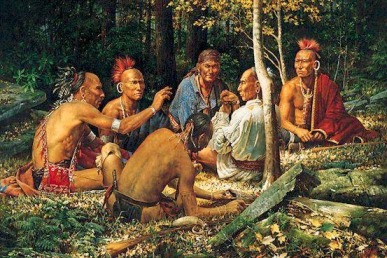Who were the Iroquois?
Since my research of possible Cherokee ancestry uncovered the fact that the Cherokee were originally known as a tribe separated from their ancestral tribe, the Iroquois, my next undertaking was to research the Iroquois Indians.
A recent article concerning newly discovered DNA linking both the native tribes of North and South America with a common ancestral thread sparked my interest. Those new findings also triggered much discussion among the scientific and archeological communities whose conclusions have yet to be solidified. For many years, it has been widely accepted that these native Americans, both South and North of the equator, were spawned by Siberian peoples that traversed the Bering Strait during a time of relatively easy travel, some 23,000 years ago. To quote from the article (‘Mysterious link emerges between Native Americans and people half a globe away’ published online by the Sciencemag.org): (1)
“They concluded that all Native Americans, ancient and modern, stem from a single source population in Siberia that split from other Asians around 23,000 years ago and moved into the now-drowned land of Beringia. After up to 8000 years in Beringia—a slightly shorter stop than some researchers have suggested (Science, 28 February 2014, p. 961)—they spread in a single wave into the Americas and then split into northern and southern branches about 13,000 years ago (see map, below).”

|
Rather than involve ourselves in depth in an area of scientific and archologic complexity, I will attempt to sum up the article in a simplistic manner which may help us to derive the origins of the Iroquois tribes as well as that of their foes in North America. It seems the common DNA of modern tribes includes a connection to not only the Siberian peoples, but to those who populated the islands of Australia and Melanesia which are shown to be distantly contiguous to the Asian continent which housed the Siberian peoples. The argument now centers around not the known fact of their common ancestry, rather the dates and times of migration which would have led to insertion of this common genetic material. Did it occur prior to that initial migration over the Bering Strait? Or, did some Australo-Melanese group migrate by sea or land into the Americas and mingle their blood with that of the earlier arrivals? We will not worry about that issue here, but will include this fascinating commonality as part of this investigation into our possible Indian heritage. One thing seems for certain to this non-scientific personage, it had to have occurred early in their exploration and occupation of the Americas for it to be common to every Indian population of today who submitted their DNA for analysis.
Now to delve into the social and political structure of the Iroquois Indians. First of all, the name “Iroquois” was a name given the tribe by their enemies, the Algonquin, which was “Iroqua” (Irinakhoiw), meaning “rattlesnakes”. The French added their Gallic suffix “-ois” turning the insult into the name: Iroquois. The Iroquois actually called themselves the “people of the long house” or Haudenosaunee.

|
The Iroquois were a matrilineal society. Land was held by the women, the longhouses built on that land were owned by the women and the men who fathered their children were invited in to that home to become part of her clan, but had responsibilities assigned to them by those women: primarily, hunting, fishing, building the longhouses, and providing the armed force to protect and preserve the existing community and to conquer enemy tribes in order to expand their territory and prestige. Some of these longhouses could become more than 200’ in length as the clan evolved and grew and could house up to 20 families.

|
The women of the clan were governed by a clan mother who had great power. She assigned duties and determined hierarchical prestige for both men and women of the clan. Each Iroquois tribe was comprised of three clans: wolf, bear and turtle, although their associated tribes, the Seneca and Huron had eight clans which included the additional hawk, deer, snipe, crane, and beaver. The work of the women was primarily to provide the sustenance for the clan. The three sisters, corn, bean and squash, provided the primary diet, augmented by the fish and game provided by the men. The women planted, nurtured and harvested the fields which were fertilized by the entrails and other remnants of the fish and game. The women also became expert in knowledge of the wild edible grasses, leaves, nuts, berries, barks and roots which could augment their diet or provide healing benefits. Because their agricultural diet was so limited, they exhausted the land over a number of years as well as the fish and game available to them which prompted a relocation of the tribe every 10-30 years.
The clan mothers established a constitution and political structure that preceded any contact with European explorers. The complexity, logic, and success of their ruling method, therefore, was not influenced by their European contact but, in fact, contributed to the Europeans admiring and utilizing many aspects of that structure. The men of the tribe were chosen by the clan mothers to rule as sachems. Fifty men were awarded the title of sachem, known by some of the tribes as lords and by others as peace chiefs. These sachems ruled during times of peace, but during times of war, the power shifted to the war chiefs, who were also selected by the women. These war chiefs were selected on the basis of familial connection or birth, experience and ability but ruled only during times of war whereas the sachems generally served for life unless removed for misconduct or incompetence. In the council of sachems, a complicated method of assigned strength for voting was based on tribal prestige: “Onondaga 14; Cayuga 10; Oneida 9; Mohawk 9; and Seneca 8” (ibid, Sultzman). One could see the modern day electoral college and representation of states in today’s Congress and Senate mirroring that logic.

|
The Iroquois were, then, primarily farmers. But a more fierce warrior could not be found. They defeated enemy forces many times their number and size and, eventually, gained control of most of the Northeast of what would become the United States and the Eastern half of what is now Canada. The men of the tribe scraped off all body hair save and except for their signature scalplock, the Mohawk! They used shells from the oysters to perform their ritual exfoliation. The women of the tribe, however, wore their hair long and gained pride in the luxurious masses of dark, full hair.
One of the darker sides of the Iroquois warlike habits included the ritualistic cannibalism of their defeated foes which has been shown by archeological means to have begun around 1400. I am sure this instilled fear and loathing among the Algonquin and Siouan, the Mahican and Lakota (Delaware) peoples as well.
The Iroquois confederacy was made up, originally, of five associated tribes: the Cayuga, Mohawk, Oneida, Onondaga, and Seneca peoples. Later, a sixth tribe, the Tuscarora, was added and the Five Nations became known as the Six Nations. (See: Google Definition for Iroquois.) A direct quote from historian Lee Sultzman furnishes the greatest clarity as to the formation of the Iroquois League: (2)
The central authority of the Iroquois League was limited leaving each tribe free to pursue its own interests. By 1660, however, the Iroquois found it necessary to present a united front to Europeans, and the original freedom of its members had to be curtailed somewhat. In practice, the Mohawk and Oneida formed one faction in the council and the Seneca and Cayuga the other. The League's principal sachem (Tadodaho) was always an Onondaga, and as "keepers of the council fire" with 14 sachems (well out of proportion to their population), they represented compromise. This role was crucial since all decisions of the council had to be unanimous, one of the League's weaknesses. There was also a "pecking order" among members reflected by the eloquent ritual language of League debate. Mohawk, Onondaga, and Seneca were addressed as "elder brothers" or "uncles," while Oneida, Cayuga, and Tuscarora were "younger brothers" or "nephews."
This hierarchical schism within an aligned tribal structure reflected the social structure which would set the Iroquois apart from other native American-Canadian tribes and which would provide both their greatest strength and ultimate weakness. Although they scrupulously pursued every remnant of the defeated tribe in an attempt to either win them over to association with their League by diplomacy or eradicated them, the tribes so absorbed were never granted equal status. The Iroquois believed themselves to be superior in intellect, power, and knowledge and treated absorbed peoples as secondary citizens thus creating segments of unrest and resentment.
The story of the Iroquois would not be complete without reviewing what role they would play in the colonization of the land that would become the United States of America. When the French first explored the New World, they valued the furs which would bring wealth to them personally and prestige to the ruling class that supported their exploration. The story of the fur trade and the wars, diplomatic alliances, betrayals, and internal strife that it caused is historic. It is also much too complicated to relate in this article. The Iroquois were known not only for their fierce and powerful warriors, but for the sophistication and perfection of their diplomatic skills. Those many years negotiating among the various factions of the Five Nations tribes served their leaders well in their interaction with the French and later the British.
Oh, yes. The British. For the ultimate diminishment of the Iroquois’ power and control would lie in their unfortunate alliance with the Redcoats during the American Revolution. After a series of betrayals by the French, who played the Algonquin and associated tribes against their perpetual foes, the Iroquois tribes, the decision was ultimately made to champion and assist the Brits in their war against the rebelling colony in the New World. This would lead to the ultimate defeat of the Brits and a distrust of the Iroquois that would not serve them well in the years following the establishment of the United States.
Following the Revolutionary War, we would see the various factions of the Iroquois separated by failures of various attempted treaties, hostile internal strife, and distrust. Many of the tribe, beset by hostility on many sides and defeated by the outcome of their untimely and ill-ordained alignment with the British would lose trust in the League itself and in its leaders. Ultimately, segments of tribes would be relocated to reservations, relocate voluntarily to new frontiers and assimilate into other cultures.
Today, the peoples inhabit reservations in Oklahoma, (Seneca-Cayuga), New York (Onondaga reservation), and in Wisconsin (the Oneida) but primarily in New York. Many returned to Canada where a large population of Mohawk reside on the St. Regis and Six Nations reserves in Ontario and in the Caughnawaga Reserve in Quebec. Many Cayuga are also located in the Six Nations Reserve. The Mohawk and Oneida who largely inhabit New York are fabled steelworkers, known for their daunting lack of fear for heights. A large gambling casino is also operated by them in Syracuse, New York. Most have been converted to the Christian faith, although a few remain followers of the ancient 18th century Seneca prophet Handsome Lake, who was strongly influenced by the Quakers. (3)
What marvelous things we can discover from our armchairs! This is by no means a complete history of the Iroquois. I doubt any encyclopedia even could contain their history for it stretches back thousands and thousands of years into the depths of the Asian continent and, by the tiny bit of research revealed by the most modern of methods, DNA examination, proves some of the truths will remain mysterious and … hidden. For now, at least.
Bibliography:
(1)
http://news.sciencemag.org/archaeology/2015/07/mysterious-link-emerges-between-native-americans-and-people-half-globe-away:)
(2) http://www.tolatsga.org/iro.html, Iroquois History, by Lee Sultzman.
A marvelous website has existed online for many years and
contains much of the work of historian Lee Sultzman. The website was
created as a means of pooling knowledge of the history of native
American Indian tribes and was the brainchild of Sultzman to provide a
place where peers could absorb the material presented, furnish comments
or corrections and thereby further a common history of each of the 240
tribes to be represented at that site. Although there now exists a
comment by Jordan S. Dill who is listed as the person owning and
maintaining the site: “All visitors here should also note that the
author of the Histories, Lee Sultzman, has not communciated with me for
years. Accordingly, I can only assume that the Histories you see at this
site are the only Histories you will ever see at this site. Bottom
line? Expect no more.” Website: http://www.dickshovel.com/up.html
(3) http://www.infoplease.com/encyclopedia/society/iroquois-confederacy-the-iroquois-today.html
A marvelous website has existed online for many years and contains much of the work of historian Lee Sultzman. The website was created as a means of pooling knowledge of the history of native American Indian tribes and was the brainchild of Sultzman to provide a place where peers could absorb the material presented, furnish comments or corrections and thereby further a common history of each of the 240 tribes to be represented at that site. Although there now exists a comment by Jordan S. Dill who is listed as the person owning and maintaining the site: “All visitors here should also note that the author of the Histories, Lee Sultzman, has not communciated with me for years. Accordingly, I can only assume that the Histories you see at this site are the only Histories you will ever see at this site. Bottom line? Expect no more.” Website: http://www.dickshovel.com/up.html






No comments:
Post a Comment